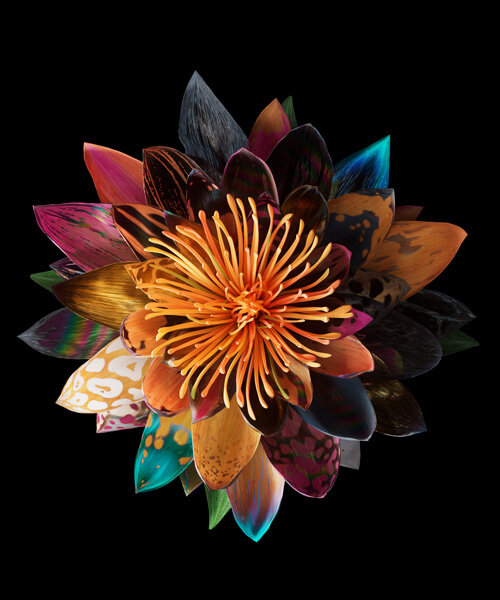heterosis: a series of immersive, gamified metaverse experiences
From rendering fantastical kinetic sculptures and capturing illusory photographs, to experimenting with the technologies of the day, British multi-media artist Mat Collishaw has long explored innovative, cross-disciplinary creative expressions. The artist’s most recent venture sees him make his first mark on the Web3 sphere with Heterosis — a first-of-its-kind series of dynamic, digital metaverse experiences. Interactive and immersive, the project has been developed using new technology and game mechanics and built upon a uniquely collaborative digital network to unlock new levels of participation and co-creation on the blockchain.
The Heterosis experience’s two key components — a dynamic, breedable NFT collection of hyperrealistic flowers, and an immersive metaverse garden environment — are made possible only by the decentralized virtual context and real-time interactions of the collectors which shape the unexpected outcomes. The project invites collectors to participate in a venturous game to hybridize, cultivate, and collect their own bespoke animated flowers. Each product shapes an ever-expanding collection of dynamic NFTs that fuse computer algorithms with genetic codes of flowers to enable the hybridization and mutation of the collectibles.
The project is set amid the backdrop of a a hyperrealistic, post-apocalyptic emulation of London’s National Gallery called the Greenhouse. Within this centralized immersive, social and persistent digital environment, collectors can adopt an avatar, roam the garden’s surreal environment, and interact with other participants while perusing all Heterosis flowers in their current iteration and observing their renderings unfolding in real-time in the cloud.
Ahead of the collection’s drop on March 8th, 2023, designboom spoke with Mat Collishaw to uncover more about the process, his fascination with breeding flowers, his experiences in working in the digital realm, and his insights into the state of the NFT boom. Read our interview in full below.

all images © Snark.art | by Mat Collishaw and Danil Krivoruchko for Heterosis, 2023
interview with mat collishaw
designboom (DB): To begin with, how did the Heterosis project and collaboration come about?
Mat Collishaw (MC): I’d been developing an idea for a collection with a centralized, social, persistent, immersive environment for some time. Then I started working on an idea I’d had about flower breeding.
The spike in NFT prices has often been compared to the speculative bubble which instigated Tulip mania in the 17th century and I read several books on the subject. The more I read the more interesting and stimulating the parallels and differences with NFT collecting became.
Several mechanics were introduced to our project during a lot of long working sessions with Antoine from El Gabal. I was also in contact with Nadia Taiga from Snark.art who was about to drop a dynamic collection with Michael Joo, an old friend. Michael built OG:Crystals with Danil Krivoruchko who did an amazing job building the collection. All these elements then coalesced into the project we are about to launch on OG.Art.

Mat Collishaw makes his first mark on the Web3 sphere with Heterosis
DB: How did you further develop this concept of ‘breeding’ hyper-realistic flowers that are NFTs in a virtual greenhouse, and somewhat recreating a virtual flower market?
MC: I’ve been making artworks for years using flowers, they are a handy vehicle for ideas plus they’re exquisite to look at and intriguing complex organisms. My grandfather hybridized flowers for a living so I grew up vaguely aware that it was a rewarding occupation. I’m fascinated by the mystery involved in combining different flowers to produce a hybrid offspring. The resulting flowers are always a combination of informed choice and chance occurrence.
It occurred to me that computer code could simulate genetic code and participants could attempt to engineer their flowers with hidden traits or recessive genes being the element of chance. It’s genuinely thrilling to see these mutations emerge. I like the idea that the artwork is a multilayered concept and within the parameters established collectors can become participants.
Creating the centralized greenhouse space was always part of the plan as it contributes an engaging and innovative overview of the entire flower collection while also presenting the opportunity to compare new digital media with older forms of art production (oil painting) that feature in our recreation of the National Gallery.

a dynamic, breedable NFT collection of hyperrealistic flowers
DB: An intriguing comparison has been raised between Tulip mania and the modern day NFT marketplace. Can you expand more on this parallel and its implications in today’s context?
MC: The big innovation with NFTs seems to be the ability to guarantee ownership of an ephemeral asset which is something that tulip breeders were struggling with. Flowers are by their nature seasonal but transactions in the 17th century happened all year around, mostly when there were no flowers in sight. This meant that there was often a time lag between a transaction and a payment. Understandably, a significant number of collectors didn’t want to pay the high prices they had agreed to when the prices spiked in 1637, and as they didn’t pay immediately, quite a few reneged on their agreement, leading to a breakdown of trust in this otherwise very reliable community. This was the real damage inflicted after the market crash — it appears all the collectors were reasonably wealthy so no one was thrown out on the street, but the tight network between them was fractured.
Fortunately, blockchain eliminates this danger. It’s a perfect solution for the ownership and trading of ephemeral assets. Incidentally, collectors continued to buy and sell tulips for decades after the crash, the spike in prices eliminated some of the more capricious speculation and trading resumed as normal.

the project fuses computer algorithms with genetic codes of flowers
DB: In terms of rendering the flowers and their hybridization process, what elements affect how each flower is cultivated? And how did you digitally capture this at each various growth stage?
MC: Essentially, a collector can choose to breed their flower with any other flower in the collection. They can then inherit properties of the chosen flower to enhance their own flower’s beauty, rarity, or value. The original flower then mutates into a new one, although it’s easily possible to reverse this process. No new NFTs are generated, so the collection always remains the same size, unlike in for example crypto kitties where the volume increases exponentially on breeding. After a certain amount of breeding, collectors can also unlock new flower species and their flower will then switch to this new rarer species. Again, this process can be reversed. All collectors will set their own price for other collectors to breed with their flower, so if a collector has a particularly rare flower trait, they can charge a higher price than a collector with a flower with more common traits. Properties include everything you would find on a real flower: the number of petals, length of petals, pointiness of petals, curvature, edge sharpness or frillness, colour, patterns etc. Then there are also special traits drawn from processes I have used in previous artworks: ghostly transparent petals, ultraviolet, animal skin etc.

DB: Can you tell us about the gamification element for this art project?
MC: The artwork is the entire project and we have implemented certain ‘game’ mechanics within it on OG.Art platform. As an artist I’m fascinated by how we ascribe the idea of beauty. In the market — and this is certainly something that happened with tulip collecting — a flower is considered beautiful until the market becomes saturated with that particular flower. Then when a more novel, rarer flower appears, this new flower is then considered more beautiful. The rarer the asset the more beautiful and valuable it appears to be. These are market forces dictating what is deemed beautiful which is perverse yet understandable. I’m very interested to find out how this plays out in the collection we’ve built.
This is a nice quote from Joost van Ravelingen, a botanist and poet in 1618: ‘Here in this country people value most the flamed, winged, speckled, jagged, shredded, and the most variegated count for most, and the ones that are the most valued, are not the most beautiful or the nicest, but the ones which are the rarest to find; or which belong to one master, who can keep them in high price or worth.’

developed in Houdini, the flowers reveal ghostly transparent petals, ultraviolet, animal skin etc.
DB: What are the project’s co-creation and community building aspects and goals?
MC: Nadia Taiga initially invited me to work with Snark.art on a collection. Vlad Rafeev was already a Snark.art collaborator and team member and has been superb at making the whole project work, getting it on a chain etc. Danil Krivoruchko has done an outstanding job not only creating convincing and beautiful flowers but building them in a way that they can mutate and evolve on the fly, which is no mean task. Antoine Cardon has developed the centralised Greenhouse space which was also a huge challenge. Nik Taylor helped build the convincing looking recreation of the National Gallery. Vlad, Danil and Antoine were mainly responsible for the various mechanics we introduced. We’ve had weekly, bi-weekly and daily meetings to keep everyone updated and in sync. There are quite a few other invaluable players in the team but I’m not sure how much more I should go on!
We’d love for the community to participate in not only the flower’s evolution but in creating a fertile arena in which collectors can contribute feedback, criticism and ideas for potentially improving and refining the project. We’re planning some exquisite IRL collectors rewards, plus talks and conversations in the Greenhouse with members of the Heterosis team.
The community is absolutely key as the collection needs engagement to evolve, the flowers aren’t dynamic if less participants are involved. The interface for the project is on OG.Art platform.

Heterosis unlocks new levels of participation and co-creation on the blockchain
DB: You’ve worked with various mediums in the past — traditional art, zoetropes, photography, and even integrating technology like VR. How did your practice evolve to traverse between physical and digital realms?
MC: Digital media pervades every artwork I create. Even if the final work is an oil painting I will have generated or manipulated the original image using some kind of software. I enjoy creating works in the physical world, I like the fact that people have to navigate a tangible object and to do that in their own time with some agency. Being physically in front of an artwork forces the viewer to traverse it in a way which hopefully stimulates thought of some kind.
When I made my VR installation ‘Thresholds’, I created a room scale equivalent of everything you were seeing in the headset. The whole room was employing passive haptics. It was a weird and uncanny thing to experience.

DB: You’ve previously mentioned that you’re not so ‘techy’. Has this project and your experiences with Web3 changed your opinion at all?
MC: I struggle to understand a lot of what’s going on underneath the bonnet as I have no knowledge of coding. Fortunately, I have several acquaintances that are! Consequently, I’m not too intimidated by it. I enjoy learning and being part of a team that is pushing the boundaries of what is possible technically, while I hope, maintaining conceptual integrity.

‘I’m fascinated by the mystery involved in combining different flowers to produce a hybrid offspring’

a first-of-its-kind series of dynamic, digital metaverse experiences

the project invites collectors into a venturous game to hybridize and collect their own bespoke animated flowers
ART INTERVIEWS (102)
METAVERSE (51)
NFT (NON-FUNGIBLE TOKEN) (100)
PRODUCT LIBRARY
a diverse digital database that acts as a valuable guide in gaining insight and information about a product directly from the manufacturer, and serves as a rich reference point in developing a project or scheme.


















